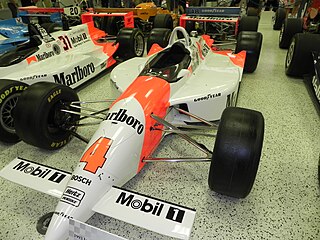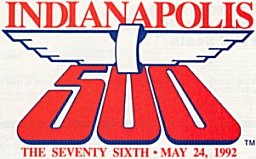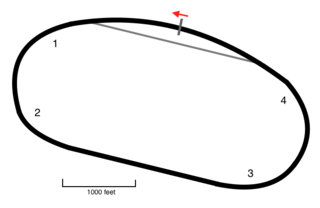
The 79th Indianapolis 500 was held at the Indianapolis Motor Speedway in Speedway, Indiana on Sunday, May 28, 1995. Sanctioned by USAC, it was part of the 1995 CART PPG Indy Car World Series season. Jacques Villeneuve won in his second start. After dominating the 1994 race and the 1994 IndyCar season, Marlboro Team Penske failed to qualify for the race. Two-time and defending Indy 500 winner Al Unser Jr. and two-time winner Emerson Fittipaldi (bumped) could not get their cars up to speed. A noticeable period of decline followed for the team until 2000 when Gil de Ferran won the CART championship, and subsequently the team returned to Indianapolis in 2001.

The 77th Indianapolis 500 was held at the Indianapolis Motor Speedway in Speedway, Indiana on Sunday, May 30, 1993. Emerson Fittipaldi took the lead with 16 laps to go, and won his second career Indy 500 victory. The race was sanctioned by USAC and was part of the 1993 PPG Indy Car World Series. Several sidebar stories during the month complemented one of the most competitive Indy 500 races in recent years.

The 76th Indianapolis 500 was held at the Indianapolis Motor Speedway in Speedway, Indiana, on Sunday, May 24, 1992. The race is famous for the fierce battle in the closing laps, as race winner Al Unser Jr. held off second place Scott Goodyear for the victory by 0.043 seconds, the closest finish in Indy history. Unser Jr. became the first second-generation driver to win the Indy 500, following in the footsteps of his father Al Unser Sr. He also became the third member of the famous Unser family to win the race.

The 75th Indianapolis 500 was held at the Indianapolis Motor Speedway in Speedway, Indiana, on Sunday, May 26, 1991. Rick Mears won from the pole position, becoming the third four-time winner of the Indy 500, joining A. J. Foyt and Al Unser. During time trials, Mears also established an Indy record by winning his sixth career pole position. The month of May for Mears was tumultuous, as he suffered his first ever crash at Indy since arriving as a rookie in 1977. The wreck during a practice run totaled his primary car, and broke a bone in his right foot. Mears kept the injury mostly secret, and later admitted that the pain he experienced during the race was so bad, he had to cross his legs in the car and push the accelerator pedal down with his left foot.

The 74th Indianapolis 500 was held at the Indianapolis Motor Speedway in Speedway, Indiana on Sunday, May 27, 1990. Dutchman Arie Luyendyk took the lead with 32 laps to go, and earned his first-ever victory in championship-level competition. It was the second consecutive year the Indy 500 was won by a foreign-born competitor, the first time that had occurred since 1965–1966. Luyendyk completed the 500 miles at an average speed of 185.981 mph (299.307 km/h), a record that stood for 23 years until 2013. In reference to the long-standing speed record, the 1990 race had often been referred to as "The Fastest 500."

The 73rd Indianapolis 500 was held at the Indianapolis Motor Speedway in Speedway, Indiana on Sunday, May 28, 1989. Two-time World Drivers' Champion Emerson Fittipaldi of Brazil became the first foreign-born winner of the race since 1969, and first non-American winner since 1966. Though Fittipaldi started on the front row and dominated much of the race, he found himself running second in the waning laps. Michael Andretti passed Fittipaldi for the lead on lap 154, then led until his engine blew. Al Unser Jr. moved up to second, but trailed Fittipaldi by a big margin. Gambling on fuel mileage, Unser Jr. caught up to Fittipaldi after a fortuitous caution period on lap 181, and subsequently took the lead on lap 196.

The 72nd Indianapolis 500 was held at the Indianapolis Motor Speedway in Speedway, Indiana, on Sunday May 29, 1988. Team Penske dominated the month, sweeping the top three starting positions with Rick Mears winning the pole position, Danny Sullivan at the center of the front row, and Al Unser, Sr. on the outside. Mears set a new track record, becoming the first driver to break the 220 mph barrier in time trials. On race day, the Penske teammates proceeded to lead 192 of the 200 laps, with Rick Mears taking the checkered flag, his third-career Indy 500 victory. The race represented the milestone 50th victory in Championship car racing for owner Roger Penske and Penske Racing.

The 71st Indianapolis 500 was held at the Indianapolis Motor Speedway in Speedway, Indiana, on Sunday May 24, 1987. After dominating practice, qualifying, and most of the race, leader Mario Andretti slowed with mechanical problems with only 23 laps to go. Five laps later, Al Unser Sr. assumed the lead, and won his record-tying fourth Indianapolis 500 victory. During the month of May, an unusually high 25 crashes occurred during practice and qualifying, with one driver in particular, Jim Crawford, suffering serious leg injuries.

The Firestone Indy 400 was an IndyCar Series race held at Michigan International Speedway in Brooklyn, Michigan. The event was most recently held in 2007. From 1981 to 2001, the event was better-known as the Michigan 500, and was held in high prestige. During its heyday of the 1980s, the race was part of Indy car racing's 500-mile "Triple Crown".

The Detroit Grand Prix is an IndyCar Series race weekend held on a temporary circuit in Detroit, Michigan. The race has been held from 1989 to 2001, 2007 to 2008, and since 2012. Since 2012, the event has been scheduled for the weekend immediately following the Indianapolis 500.

The Honda Indy 200 at Mid-Ohio is an IndyCar Series race held at Mid-Ohio Sports Car Course in Lexington, Ohio. Professional open wheel races at the facility date back to 1970. The U.S. Formula 5000 series ran from 1970 to 1976, and the revived Can-Am series ran from 1977 to 1980.

The Grand Prix of Portland is an Indy Car Series race held at Portland International Raceway in Portland, Oregon. The race was held every year from 1984 through 2007 first as a CART series race, then as part of Champ Car World Series. After a ten-year absence, the race returned to the IndyCar Series for the 2018 season.

The Grand Prix of Road America, also known as the Sonsio Grand Prix at Road America for sponsorship reasons, is an IndyCar Series race held at Road America in Elkhart Lake, Wisconsin. For twenty-five years, the event was part of the CART series, with the first race being held in 1982. The event was put on hiatus in 2008 after the unification of Champ Car into the Indy Racing League.
The 1985 CART PPG Indy Car World Series season was the 7th national championship season of American open wheel racing sanctioned by CART. The season consisted of 15 races. Al Unser Sr. was the national champion, and the rookie of the year was Arie Luyendyk. The 1985 Indianapolis 500 was sanctioned by USAC, but counted towards the CART points championship. Danny Sullivan won the Indy 500, in dramatic fashion, a race that became known as the "Spin and Win."

The 1987 CART PPG Indy Car World Series season was the 9th national championship season of American open wheel racing sanctioned by CART. The season consisted of 16 races, and one non-points exhibition event. Bobby Rahal was the national champion, winning his second-consecutive title. The rookie of the year was Fabrizio Barbazza. The 1987 Indianapolis 500 was sanctioned by USAC, but counted towards the CART points championship. Al Unser won the Indy 500, his record-tying fourth victory at Indy.
The 1988 CART PPG Indy Car World Series season was the 10th national championship season of American open wheel racing sanctioned by CART. The season consisted of 15 races, and one non-points exhibition event. Danny Sullivan was the national champion, winning for Team Penske. The rookie of the year was John Jones. The 1988 Indianapolis 500 was sanctioned by USAC, but counted towards the CART points championship. Rick Mears won the Indy 500, his third victory at Indy.

The Firestone Grand Prix of Monterey is an IndyCar Series race held at WeatherTech Raceway Laguna Seca near Monterey, California. The event dates back to 1960, and became an American open wheel race in 1983. The race was part of the CART/Champ Car series from 1983 through 2004. After a fifteen-year hiatus, the event returned in 2019 as part of the IndyCar Series, replacing Sonoma.
The Marlboro Challenge was an all-star race in the CART series race held from 1987–1992, sponsored by cigarette brand Marlboro. After 1992, the race was discontinued, in part because Phillip Morris reorganized its race sponsorship after the Marlboro Grand Prix of New York fell through. The race was considered a non-points exhibition race, and did not count towards championship standings or official statistics.

The 1995 PPG Indy Car World Series season, the seventeenth in the CART era of U.S. open-wheel racing, consisted of 17 races, beginning in Miami, Florida on March 5 and concluding in Monterey, California on September 10. The PPG Indy Car World Series Drivers' Champion and Indianapolis 500 winner was Jacques Villeneuve. Rookie of the Year was Gil de Ferran. This was the last season before the formation of the Indy Racing League by Indianapolis Motor Speedway owner, Tony George, and the last time the USAC-sanctioned Indianapolis 500 would appear in the Series.

The 1994 PPG Indy Car World Series season was the 16th national championship season of American open wheel racing sanctioned by CART under the name "IndyCar". The season consisted of 16 races. Al Unser Jr. was the national champion, his second CART title, and the rookie of the year was Jacques Villeneuve. The 1994 Indianapolis 500 was sanctioned by USAC, but counted towards the CART points championship. Al Unser Jr. won the Indy 500 from the pole position, his second career victory in that event.


















